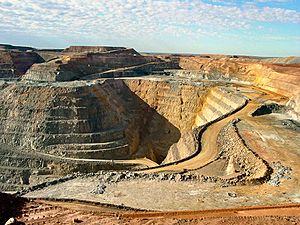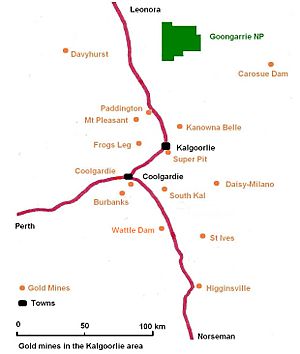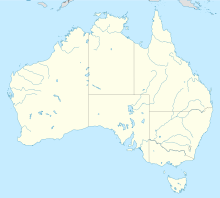Super Pit gold mine facts for kids

Fimiston Open Pit gold mine, c. 2005
|
|
| Location | |
|---|---|
| Location | Kalgoorlie |
| State | Western Australia |
| Country | Australia |
| Coordinates | 30°46′29″S 121°30′34″E / 30.77472°S 121.50944°E |
| Production | |
| Production | 456,000 troy ounces (14.2 t) |
| Financial year | 2019 |
| History | |
| Opened | 1893 |
| Owner | |
| Company | Kalgoorlie Consolidated Gold Mines (Saracen Mineral Holdings 50%, Northern Star Resources 50%) |
| Year of acquisition | 2020 |
The Fimiston Open Pit, often called the Super Pit, is a very large open-cut gold mine in Australia. It was the biggest open-cut gold mine in Australia until 2016. Another mine, the Newmont Boddington gold mine, became bigger that year.
The Super Pit is located near the city of Kalgoorlie in Western Australia. It's a huge hole in the ground! It's about 3.5 kilometers (2.2 miles) long. It's also 1.5 kilometers (0.9 miles) wide and more than 600 meters (2,000 feet) deep. That's deeper than many tall buildings!
The Super Pit is owned by a company called Kalgoorlie Consolidated Gold Mines. Two other companies, Saracen Mineral Holdings and Northern Star Resources, each own half of it. In 2019, the mine produced about 456,000 ounces of gold. Around 1,100 people work at the Super Pit.
Contents
How the Super Pit Started
Before the Super Pit existed, there were many smaller underground mines in the area. These included mines like Paringa, Oroya, and Brown Hill. People wanted to combine them into one giant open pit.
A businessman named Alan Bond tried to do this first, but he couldn't finish the job. The Super Pit was finally created in 1989. It was made by Kalgoorlie Consolidated Gold Mines. This company was a partnership between Homestake Gold of Australia and Gold Mines of Kalgoorlie.
Over the years, different companies have owned parts of the Super Pit. Barrick Gold became a part-owner in 2001. Newmont Mining Corporation joined in 2002. More recently, Saracen Mineral Holdings bought Barrick Gold's share in 2019. Northern Star Resources bought Newmont Corporation's share in 2020.
Where the Gold Is Found
Most of the gold at the Super Pit is found in special rock formations. These are called "ore lodes." They were formed by ancient cracks in a rock type called the Golden Mile Dolerite.
The area around Kalgoorlie-Boulder-Fimiston has been famous for gold for a long time. It's often called the Golden Mile. This is because so many rich gold mines were found close together there. Even though it's called a "mile," the gold deposits actually spread over an area more than 2 kilometers long and 1 kilometer deep!
How Gold Is Mined
Mining at the Super Pit involves a few big steps. First, workers use drills to make holes in the rock. Then, they use explosives to blast the rock apart. After the blast, huge shovels scoop up the broken rock. Giant dump trucks then carry the rock away. About 15 million tonnes of rock are moved each year! Most of this rock is waste, but some contains gold.
The gold found in the Golden Mile is a bit unusual. It's often mixed with other minerals called "telluride" and "pyrite." To get the gold out, the ore (rock with gold in it) goes through a special process:
- First, the ore is crushed into smaller pieces.
- Then, it goes through a "gravity circuit." This helps to collect any "free gold" that is easily separated.
- Next, a process called "flotation" is used. This separates the gold-rich pyrite-telluride mixture from the rest of the rock.
- This gold-rich mixture is then treated. It might go to a special grinding mill at Fimiston. After grinding, a chemical process called cyanidation is used to dissolve the gold.
- Sometimes, the mixture is trucked to another plant called Gidji, about 20 kilometers north of Kalgoorlie. There, it also goes through grinding and cyanide extraction to get the gold.

Gold Production Numbers
Here are some past production numbers for the Super Pit:
| Year | Gold Produced | Gold Grade | Cost to Produce |
| 1998-99 | 718,554 ounces | 2.37 grams per tonne | US$236 per ounce |
| 2000 | 715,164 ounces | 2.27 grams per tonne | A$325 per ounce |
| 2001 | 616,344 ounces | 2.14 grams per tonne | A$397 per ounce |
| 2002 | 720,050 ounces | 1.73 grams per tonne | A$222 per ounce |
| 2007 | 628,000 ounces | 1.53 grams per tonne | |
| 2008 | 612,000 ounces | 1.56 grams per tonne | |
| 2009 | 690,000 ounces | US$609 per ounce |
See also
 In Spanish: Mina de oro Super Pit para niños
In Spanish: Mina de oro Super Pit para niños


